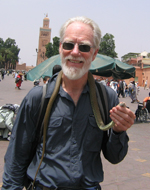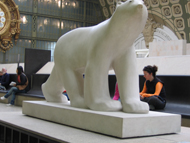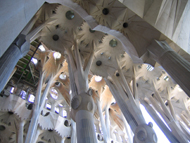Editor’s Note: Lane’s story of his trip will come in two parts. This first part will wander through some of the stone wonders of Europe, leaving us in Croatia looking out a bus window at the Dalmatian Coast. In the 2nd part (the January/February SN) we’ll head south from Dubrovnik, Croatia, stopping here and there until we run out of rocks in Cape Town. It’s all east, and home then, with one last rock stop in Viet Nam. Bon voyage!
Let’s face it, stone (rock if you prefer) is just about everywhere: in the mountains, in the valleys, at the bottom of the sea, even lying there in our backyards, defying us, or enticing us. And let’s face one more truth; we have a thing for stone. I could be referring to the we that is all of humanity, but let’s talk for a while about the we who carve stone. We’ll come back to the subject of humanity at the end.
Stone comes to us from all over the planet. You might have a piece of gloriously translucent Italian alabaster. Have you ever carved African Malachite? What about that chunk of jade from the spot where most of the countries once called Indochina almost come together? We’re a lucky bunch to be able to get stone from almost anywhere in the world.
If you think I’m rambling with all this talk of stone locations, you’re right, I am rambling. Or, rather, I did last summer. Circumstances coalesced, in a way I never expected, to allow me to take a trip around the world. I’m talking about the same world the astronauts told us looks from space like a blue marble. I like calling it that. It’s good for those times when life’s current events distort my perspective.
Anyway, I just want to tell you about a few of the places where I found myself fascinated (or perhaps only bemused) by some kind of stone. My only disclaimer will be that I don’t profess to be an expert on geology or all those scientific names for the stuff. So, don’t expect a comprehensive treatise like you might get from a Ron Geitgey or a Bill Laprade. I’m just going to tell you about some rocks I saw. Okay?
So, here they come, in roughly the order in which I saw them.
I started in Dublin. The Irish spring weather was welcoming; it was sunny and warm - no, really. And, my goodness, but the Irish have been busy with stone. There were stone houses, walls, sidewalks, roads, statues, even stone lampposts. I couldn’t tell you what kind of stone it all was, but I saw that it had been assembled with skill and craftsmanship everywhere I looked, giving the whole country a look of permanence. Except, that is, for all the ruined castles. But then, by the simple virtue of their quiet, unassuming continuance, they too seem to present one with a solid feel of at least being connected to something that is lasting.
Skipping over to London, let’s take a peek into Westminster Abby. This was stone of a different sort and purpose. I’m not talking about the building (glorious enough by construction standards), but rather, about the tons and tons of marble carvings inside. They line the walls, aggressively depicting long dead sculptors’ wildest imaginations let loose over somebody or other’s small, dark crypt.
Along those walls I saw dancing skeletons, kneeling churchmen, standing orators, and all manner of reclining men and women looking appropriately tranquil, topping their model’s final resting place. I came out of there temporarily convinced that everything that could be carved from stone had been, making it a waste of time for me to wield hammer and chisel. Luckily the feeling didn’t last.
Paris was just plain stupendous. Whatever praise people heap on this city is deserved. I don’t mean to judge it as a city, but as a collection of monuments – all well scrubbed (or having it done while I watched). And there looked to be an unending supply of gilt and stone, and it all gleamed as if from the brilliance of Louis the Sun King himself. How appropriate, I thought.
I went to the Musee d, Orsay to see the Rodins, and had a picture taken with me standing beneath the legendary, glowering gaze of Balzac himself. To read that it was refused at its unveiling, by the people who commissioned it, makes me wonder about the rocky partnership between art and its sometimes timid patrons.
On my way out of the old train station turned museum, I walked up to the most wonderful white marble polar bear by Francois Pompon. Imposingly life size, it dominates a considerable space with what I took to be a dignified preoccupation with meaningful business on some polar ice flow. This was another case of me resonating with a sculpture that has long enjoyed a huge popularity without me even knowing of its existence. I don’t mind though, it’s great fun playing catch up.
I’ll just mention Gibraltar, a rather large rock enjoying much fame on its own. Having been in non English Europe for almost a month, I almost giggled with joy at being able to read the signs along the British streets at its base. Up on top of the rock, the Barbary Apes were attentive to the tourists, as if being good hosts to shirttail relatives from out town. What a glorious view we out-of-towners had from the top of that granitic insurance logo.
Next stop Barcelona. Needing a little time off, I sat the whole first day up on the escalatored hill where Gaudi built his Park Guell. That famous, sinuous, tiled bench was certainly hard on my butt, and yet too deliciously inviting to pass by.
The second day I spent at Gaudi’s really big deal: the Sagrada Familia. He worked on it for 42 years until he was run over by a streetcar on the streets of Barcelona in l926. Spanish powers that be are now finishing it according to his original plan. The surreal menage a trois of poured concrete, stone, and tile took my breath away. Still almost filled with scaffolding, the church is, even now, truly monumental. I hope I live long enough to go back and see it completed. Inside it is a forest of sprouting, organic pillars holding up a ceiling pierced all over with what will be circular, stained glass panels. Outside it looks like the stone is dripping down and, indeed, it is sometimes called The Melting Cathedral.
On my way to Rome, I passed across the island of Corsica. Near Mt. Rotondo, dozens of German hikers got off the train, shouldered their packs and set off to scale the granite ridges and spires on all sides.
When I got to Rome, I had to see the Bernini sculptures. It’s why I went there. Yes, I sometimes have a narrow view. So do we all – sometimes – if we’re lucky. Jumping into a cab, I did my best to say “to the Galleria Borghese,” in an understandable way.
The biggies were there. I saw, and as a personal token - touched, both of the Cardinal Borgheses, Apollo and Daphne, and (my favorite) Pluto and Proserpina, who are forever attended by the three headed, exquisitely carved Cerberus. I could go on, but I won’t. Suffice it to say that I have been looking at the oversize Phaidon book on Bernini and reading about him for years. Standing there, agog, I was in a true moment of traveler’s contentment.
As a quick aside, there was a distant view of Mt. Blanc in Switzerland, and a much closer look at the mountains surrounding that lovely little town in the Tyrolean Alps. You know the one just inside
Germany at its border with Austria, the one with the name as lovely as its mountains: Garmisch Partenkirchen. Looking at snowy mountains, while strolling in such immaculately civilized centers, flooded me with comforting thoughts of the stability of stone foundations.
Let’s continue on to Slovenia and go inside one of those mountains. This one isn’t granite, it’s old limestone shot full of holes. A friend named Tony Kocjan told me about the Kocjan Cave just over the border, a few kilometers N.E. of Trieste, Italy; one of my planned stopping points. The cave is in the karst plateau, and one of the more than 8,000 documented caves in Slovenia. This kind of cave is usually made by eons of water seeping down through the limestone. The Kocjan cave had a little more help from the river that pours through it.
Picture it. We’re standing on a ledge near the top of a room measuring hundreds of feet down and hundreds of feet across. The rapids, far below, sound like high wind in a stand of old growth fir. Mist rises up toward us filling the huge space like a mountain valley fills with fog. I feel like I’m looking through a camera obscura at a primitive, long ago past. The spell is broken as my multi-tasking mind reminds me, with an over zealous abruptness, that I had left my ATM card (only 3 hours ago) at a machine in the sleepy little Slovenian town of Sezana.

Having canceled that card and now moving on down the Dalmatian coast, I see what must be thousands of miles of low stone walls. The near barren Croatian landscape is completely crosshatched with them. Were they medieval property boundaries? They must have been absolutely necessary to the people who spent so much energy building them. And now no one seems to care a fig about the walls. They lay mute; whole or broken down, their once resounding voices now only silent mysteries to a traveler peering out, in his own silence, through an oversize, ultraviolet blocking, tinted bus window.

